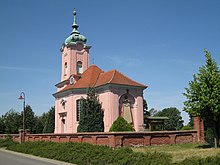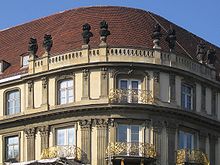Friedrich Wilhelm Dieterichs
Friedrich Wilhelm Dieterichs (also: Friedrich Wilhelm Diterichs and Dietrichs ) (born April 10, 1702 in Uelzen , † December 13, 1782 in Orpensdorf near Stendal ) was an architect, engineer and construction officer in Prussia in the 18th century. He created baroque architectural ensembles with high artistic standards in Berlin and the surrounding area and was one of the most important artists of the Frederician Rococo .
education

At the age of 15, Friedrich Wilhelm Diterichs left his hometown of Uelzen and began training in Berlin with the court and palace architect Martin Heinrich Böhme (1676–1725). Böhme worked as an employee of Andreas Schlueter in the redesign and expansion of the palaces in Berlin and Potsdam . After King Friedrich I died in 1713, the building work had shifted away from the large, luxurious buildings towards house and road construction, renovation and repair of churches, bridges, locks and factories in Prussia. Not a bad time for Diterichs to join von Böhme's office in 1717.
At the beginning of his career, Diterichs held a position as construction clerk and was responsible for the organizational issues of building. From 1719 to 1724, during the construction of the Schwedt Church, he advanced to the position of "Conductor", a title that was lower than that of engineer. Diterichs was also promoted as an architect by his teacher, and the first building that he designed and built together with Böhme in 1721 was the governor's house in Berlin, Königstrasse (today's Rathausstrasse ) at the corner of Jüdenstrasse.
Civil service and career as an architect
In 1723 Friedrich Wilhelm Diterichs entered the civil service. As the newly appointed building inspector, he was supposed to implement King Friedrich Wilhelm I's ideas for increasing civil construction in the Kurmark. Among other things, Diterichs was responsible for the territories of the offices and cities of the Altmark and Priegnitz and the Uckermark .
In addition to building construction with its special areas of civil engineering and architecture, the area of responsibility of the royal servants also included the special areas of hydraulic engineering, bridge, lock, path and dam construction as well as industrial construction. The rural industrial buildings included lime and brick kilns, cutting and grinding mills as well as the farm buildings with their breweries, which are also subordinate to the domains. In the following years, Diterichs proved that he was an excellent master of his profession with the construction of the locks in the Rhin near Ruppin (1728), in Fürstenwalde (1727), in the Neuer Graben (1726), the mill in Fürstenwalde (1729) and the new ones Bridges from Raßmannsdorf near Beeskow (1729) and Bindow under the Storkow office (1734). His first church building was the Buch Castle Church, built from 1731 to 1736 on the site of a previous building .

In 1737 Diterichs was appointed building director and in 1742 senior building director. As an employee of the architect and painter Georg Wenzeslaus von Knobelsdorff (1699–1753), he played a key role in the creation of the terraces, the crypt and the construction plans of the Sanssouci Palace in Potsdam in the 1740s ; He transferred Knobelsdorff's cracks in detail, selected the materials, concluded contracts with sculptors and stonemasons and commissioned Johann Gottfried Büring and Carl Ludwig Hildebrandt , with whom he had already terraced the vineyard, as "conductors" to build the palace. The foundation stone was laid on April 14, 1745. On May 2nd, however, Diterichs was replaced by a cabinet order as construction manager by Jan Bouman and, like Büring, returned to Berlin.
The garden inspector and chief building officer of King Friedrich II , Heinrich Ludwig Manger, describes the circumstances of the dismissal in his building history of Potsdam 1789 as follows:
“But either Diterichs had n't courted the king's sweetheart at that time (meaning Fredersdorf ) or he must have made enemies in some other way who didn't fail to play a bad trick on him. Because fourteen days after starting work ( i.e. after laying the foundation stone on April 14, 1745) Neubauer received a letter from Fredersdorf in Neisse on the 21st of this month, with the message "that the previous royal order was invalid, and the money for the Weinbergs-Lushhaus not by Diterichs, but by Baumann for payment should be assigned. " Shortly afterwards, namely on May 21st, a cabinet order from Neisse, signed by the king himself, came in on April 25th, in which it says: "Diterich's council of war should have nothing to do with my buildings in Potsdam, but all buildings for which purpose Privy Councilor Köppen will pay money, should only be led by the castellan Baumann. " In this way Dietrichs was relegated from Potsdam ... The conductor Büring immediately went to Berlin after Dieterich's departure; Hildebrand stayed here, however, and held his post as long as he could get along with Baumann ... "
Karl Friedrich Schinkel wrote around 1830:
"As early as May there was a new order from the king, according to which the building manager Dietrichs, who did not flatter the king's servants enough, had the building removed and transferred to a castellan named Boumann."
In Berlin, Diterichs was responsible for various important buildings, including the Bohemian or Bethlehem Church on today's Bethlehemkirchplatz , which was completed in 1737 .
In 1744 Diterichs married the widow of the war councilor Gustav Falcke (1693–1743) and thus became lord of the manor and court of various manors. The financial backing that came with it enabled him to quit his grueling service eight years later.
In the last few years before the end of his work as chief building director at the Kurmärkische Kammer, the renovation of the house at Unter den Linden 5 in Berlin, which later became the Prinzessinnenpalais , took place in 1748 by the Secret Finance Council von Zinnow according to Diterich's statements . With a delay, the new construction of the town hall of Templin in the Uckermark, designed by Diterichs in 1735, began.
The building at Unter den Linden 36 (today No. 11) in Berlin, which was built according to Diterich's plans in 1752 together with the neighboring house, became known under the name “ Dutch Palace ”. In place of the ruins of the Dutch Palace, which was demolished in 1963, a slightly modified replica of Diterich's governor's house , which was also blown up in 1967, was built from Rathausstrasse 19, using the salvaged, baroque, three-dimensional decorative elements of the central elevation.
Landlord and freelance architect


In 1752 Diterichs withdrew to the Orpensdorf estate near Stendal and did not reappear until the end of the Seven Years' War , now as a free and independent architect. The designs for the church, built in Orpensdorf in 1747, also come from him.
In the years 1760 to 1762 Diterichs was probably busy with the renovation of the Ermelerhaus in the Breiten Straße 11. One of the stately town houses of this time was built on behalf of the leather goods and clothing supplier Peter Friedrich Damm. The rooms designed with feudal stylistic devices made the building into an attractive representative building.
In 1762 he received from Veitel Heine Ephraim , court jeweler and Münzpächter Frederick the Great , the order, the three-story house on the corner lot Poststraße corner Mühlendamm rebuild. The representative Ephraim Palace was built between 1762 and 1769 . The two wings of the four-storey building meet at obtuse angles and supposedly form “the most beautiful corner of Berlin”.
According to Hans Kania, the manor house built in 1765 in Groß Kreutz (Havel) also goes back to a design by Diterich.
literature
- Heinrich Wilhelm Rotermund : Dieterichs (Friedrich Wilhelm) , in ders .: The learned Hanover or lexicon of writers, learned businessmen and artists who have lived and still live in and outside of the provinces belonging to the Kingdom of Hanover since the Reformation the most credible writers compiled , vol. 1, Bremen: Car Schünemann, 1823, pp. CXVIII-CXIX; limited preview in Google Book search
- Friedrich FA Kuntze: The old Berlin . Verlag für Kunstwissenschaft, Berlin 1937.
- Bodo Harenberg (editor): The Chronicle of Berlin . Chronik-Verlag, Dortmund 1986, ISBN 3-88379-082-6 .
- Rolf-Herbert Krüger: Friedrich Wilhelm Diterichs . Potsdamer Verlagsbuchhandlung GmbH, 1994, ISBN 3-910196-11-X .
- Gert Streidt, Peter Feierabend (editor): Prussia - art and architecture . Könemann Verlagsgesellschaft mbH, Cologne 1999, ISBN 3-89508-424-7 .
- Markus Sebastian Braun (Editor): Berlin - The Architecture Guide . Publishing group Econ Ullstein List, Munich 2001, ISBN 3-88679-355-9 .
Web links
Individual evidence
- ↑ oV : Dieterich, Friedrich Wilhelm in the database Niedersächsische people (new entry required) of the Gottfried Wilhelm Leibniz Library - Lower Saxon State Library [no date], as last accessed on 11 January 2018
- ^ Friedrich Nicolai : Description of the royal residence city of Potsdam and the surrounding area . Ed. V. Karlheinz Gerlach, Reclam-Verlag, Leipzig 1993, pp. 100-101.
- ^ Heinrich Ludwig Manger: Heinrich Ludewig Manger's building history of Potsdam, especially under the government of King Frederick the Second. 1. Volume, Nicolai, Berlin / Stettin 1789/90, pp. 34-35 and 46-50
- ↑ Schinkel (from: Die Residenzstadt Potsdam, reports and pictures. Ed. V. M. Hürlimann and PO Rave, Atlantis-Verlag Berlin 1933, pp. 116-118)
- ↑ Prof. Dr. Hans Kania: The manor house of Groß-Kreutz , Märkischer Heimatkalender for the Zauche from 1928, p. 34-38
| personal data | |
|---|---|
| SURNAME | Dieterichs, Friedrich Wilhelm |
| ALTERNATIVE NAMES | Dietrichs, Friedrich Wilhelm; Diterichs, Friedrich Wilhelm |
| BRIEF DESCRIPTION | German architect, engineer and construction officer |
| DATE OF BIRTH | April 10, 1702 |
| PLACE OF BIRTH | Uelzen |
| DATE OF DEATH | December 13, 1782 |
| Place of death | Orpensdorf near Stendal |

